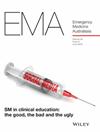Computed Tomography Scan Rates and Outcomes in Children Risk-Stratified Using the PREDICT Guideline Algorithm for Risk Stratification of Mild and Moderate Head Injuries
Abstract
Objective
Since 2021, the PREDICT Guideline for Mild to Moderate Head Injuries in Children has been widely implemented across Australia and New Zealand. We set out to describe the application of the guideline's risk stratification using an existing database.
Methods
Secondary analysis of a large multicentre prospective data set of paediatric patients with head injuries. We stratified the sample into high, intermediate, low, and very low risk categories per the PREDICT Guideline algorithm. Rates and 95% confidence intervals (CI) of computed tomography (CT), abnormal CT, and clinically important traumatic brain injury (ciTBI) were determined within these categories.
Results
Of 20,137 patients, 1847 were excluded from risk stratification as requiring immediate CT scans (GCS ≤ 13) or as special conditions. 18,290 (90.8%) were stratified into risk categories: 542 (2.9%) high, 4843 (26.0%) intermediate, 2138 (11.5%) low, and 10,767 (57.9%) very low. CT rates were 59.2% (95% CI 55.0%–63.4%) and 18.9% (17.8%–20.1%) in high and intermediate risk groups, with subsequent abnormal CT rates of 42.1% (95% CI 36.6%–47.7%) and 17.6% (95% CI 15.1%–20.2%), and ciTBI rates of 8.9% (95% CI 6.6%–11.6%) and 1.3% (95% CI 1.0%–1.6%), respectively. CT rates were 7.1% (95% CI 6.1%–8.3%) and 1.8% (95% CI 1.6%–2.1%) for low and very low risk groups, with ciTBI rates of 0.4% (95% CI 0.2%–0.8%) and 0.01% (95% CI 0.0002%–0.1%). 9 low and 1 very low risk patient had a ciTBI (2 required neurosurgery).
Conclusions
The PREDICT Guideline algorithm risk stratifies head injuries into high, intermediate, low, and very low risk patients. Two of the missed lower risk patients required neurosurgery.

 求助内容:
求助内容: 应助结果提醒方式:
应助结果提醒方式:


